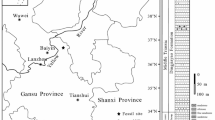Abstract
Field observation of the macromorphology and analyses of micromorphology and geochemistry were conducted to the worm-shaped veins (WSVs) in the red earth of South China. The WSVs exhibit outward features of root traces and contain the traces of stele that can be used as the definite evidence of root traces. Surrounding the worm-shaped veins there are some micro-features pressed by past root growth. Geochemical analyses indicate that the white part in the WSV was depleted in Fe content. These lines of evidence suggest the WSVs in the red earth of South China are the root traces of past forest.
Similar content being viewed by others
References
Lee, J. S., Glaciation in Lushan, Quaternary Glaciation in China (ed. Lee, J. S.) (in Chinese), Beijing: Science Press, 1975, 56–93.
de Chardin, P. T., Young, C. C., Pei, W. C. et al., On the Cenozoic formations of Kwangsi and Kwangtung, Bulletin of the Geological Society of China, 1935, 14(2): 179.
Ren, M. E., Yong, S., A preliminary study on the geomorphology and Quaternary geology in Xiangjiang River Valley, Acta Geographica Sinica, 1957, 23(4): 369.
Xiong, Y., The characteristics and origins of the Pleistocene Clay in Jiangxi Province, Geological Review (in Chinese), 1944, 9: 109.
Li, Y. Y., The origins of the white worm-shaped veins within the red earth in South China, Geological Review (in Chinese), 1965, 23(2): 144.
Gong, Z. T., Bio-geochemistry of the Red Weathering Crust, Red Earth in China (ed. Li, Q. K.) (in Chinese), Beijing: Science Press, 1983, 24–40.
Xi, C. F., On the red weathering crust in South China, Quaternary Sciences (in Chinese), 1991(1): 1.
Zhu, J. J., The origins and implications of the red earth with worm-shaped veins, Geographical Research (in Chinese), 1988, 7(4): 12.
Nanjing University, Zhongshan University, Peking University et al., Pedology and Pedogeography (in Chinese), Beijing: Higher Education Press, 1980, 1–351.
Xi, C. F., Some problems in the studies on the red weathering crust in China, Quaternaria Sinica (in Chinese), 1965, 4(2): 42.
Xiong Shangfa, Ding Zhongli, Liu Tungsheng, Comparisons of grain size characteristics of red earth from southern China with that of loess and dune sand from Beijing region, Chinese Science Bulletin, 1999, 44(18): 1690.
Retallack, G. J., German-Heins, J., Evidence from Paleosols for the Geological Antiquity of Rain Forest, Science, 1994, 265: 499.
Retallack, G. J., Field recognition of paleosols, Paleosols and Weathering Through Geologic Time: Principles and Applications (eds. Reinhardt, J., Sigleo, W. R.), Boulder: The Geological Society of America, 1988, 1–20.
Fedoroff, N., Eswaran, H., Micromorphology of Ultisols, Soil Micromorphology and Soil Classification (eds. Douglas, L. A., Thompson, M. L.), Madison: Soil Science Society of America, 1985, 145–164.
Sigleo, W., Reinhardt, J., Paleosols from some Cretaceous environments in the southern United States, Paleosols and Weathering Through Geologic Time: Principles and Applications (eds. Reinhardt, J., Sigleo, W. R.), Boulder: The Geological Society of America, 1988, 123–142.
Retallack, G. J., Soils of the Past, Boston: Unwin Hyman, 1990, 1–520.
Elick, J. M., Driese, S. G., Mora, C. I., Very large plant and root traces from the Early to Middle Devonian: Implications for early terrestrial ecosystems and atmospheric ρ(CO2), Geology, 1998, 26(2): 143.
Luo Ruying, Forest Pedology (in Chinese), Beijing: Science Press, 1983, 1–426.
Retallack, G. J., A Colour Guide to Paleosols, Chichester: John Wiley & Sons, 1997, 1–175.
Counrty, M. A., Goldberg, P., Macphail, R., Soils and Micromorphology in Archaeology, Cambridge: Cambridge University Press, 1989, 1–344.
Retallack, G. J., Early Forest Soils and Their Role in Devonian Global Change, Science, 1997, 276: 583.
Bestland, E. A., Retallack, G. J., Rice, A. E. et al., Late Eocenc detrital laterites in central Oregon: Mass balance geochemistry, depositional setting, and landscape evolution, Geological Society of America Bulletin, 1996, 108(3): 285.
Author information
Authors and Affiliations
About this article
Cite this article
Xiong, S., Ding, Z. & Liu, D. The worm-shaped veins in the red earth of South China—Pedological evidence for root traces of past forest. Chin.Sci.Bull. 45, 1800–1804 (2000). https://doi.org/10.1007/BF02886271
Received:
Issue Date:
DOI: https://doi.org/10.1007/BF02886271




